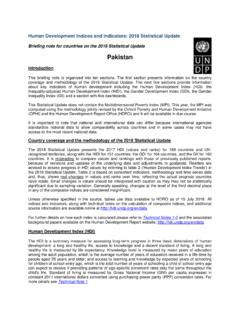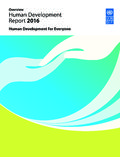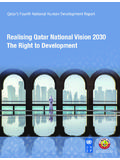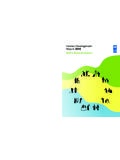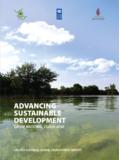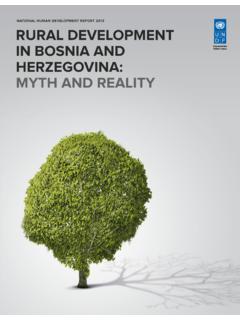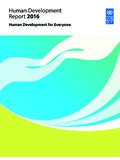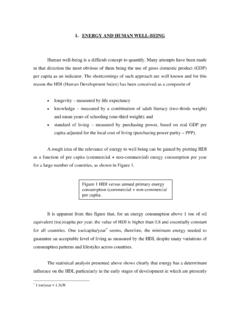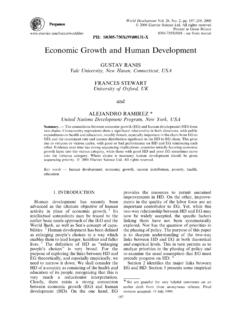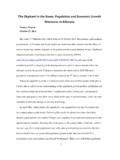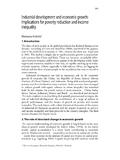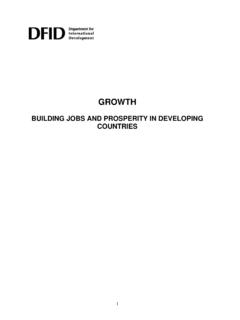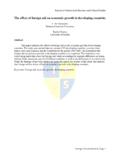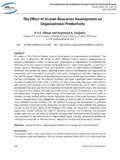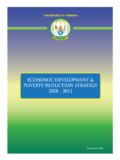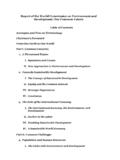Transcription of Zambia Human Development Report 2016
1 Zambia Human Development Report 2016 Industrialisation and Human DevelopmentPoverty Reduction Through Wealth and Employment Creation Empowered lives. Resilient nations. Published by theUnited Nations Development Programme(UNDP)Copyright 2016 Published by theUnited Nations Development ProgrammeUN HouseAlick Nkhata RoadP. O. Box 31966 Lusaka rights reserved. No part of this publication may be reproduced, stored in a retrieval system or transmitted, in any form or by any means, electronic, mechanical, photocopying, recording or otherwise, without prior Preface Acknowledgements Acronyms & Abbreviations Overview Chapter 1: Industrialisation and Human Development Introduction Understanding Human Development Understanding Industrialisation Linking Industrialisation and Human Development Impediments to Industrialisation in Zambia : The Dutch Disease Conclusion Chapter 2.
2 Zambia s Industrialisation ExperienceIntroduction The Colonial Capitalist Model (1964-1968) Nationalisation and Import Substitution Industrialisation (1968-1991) Structural Adjustment and Market Liberalisation Industrialisation (1991-2000) Export-Oriented Industrialisation Policy (2001 to Date) Current Economic Outlook Foreign Direct Investment in Zambia Conclusion Chapter 3: The State of Human Development in Zambia Introduction Human Development Index (HDI) Inequality-Adjusted HDI (IHDI) Gender Inequality Index (GII) Gender Development Index (GDI)Multidimensional Poverty Index (MPI) Conclusion ContentsChapter 4.
3 The Nature of Manufacturing in Zambia Introduction Zambia s Business EnvironmentComposition of Manufacturing in Zambia Textiles and Leather Industries Basic Metal Products - Non-ferrous Metal Wood and Wood Products Manufacturing -- Pharmaceuticals 1vii1ix4xiii3xi5xvii68111113131821232728 31313134373638424343434546484849 Fish Farming Livestock Production Food and Beverages Mining and Manufacturing Conclusion Chapter 5: Trade in Zambia Introduction Zambia in Trade Context Regionalism and Doing Business Indicators Trends in International Trade Estimating Economic Complexity Trade for Human Development Trade and Poverty Reduction Opportunities and Constraints Opportunities Constraints Conclusion Chapter 6: Industrialisation and Employment in Zambia Introduction The Growth-Employment Trajectory A Skills Shortage in Zambia s Labour Market Conclusion Chapter 7: Industrialisation in Zambia .
4 Structural Constraints Introduction Constraints on Infrastructure Transportation ICT Technological Deepening Energy Skills DevelopmentConclusion Chapter 8: Making Industrialisation Supportive of Human Development Introduction AgricultureAction Plan Skills Development Action plan Health Action plan MSME Development Action plan Non-Agricultural Economic Diversification 5151525253555555555761616263636464676767 7272757575767779808084858585868787888990 9090 Agricultural Goods and Manufacturing 50iiiConclusion NotesBibliography Boxes Role of a Developmental State Three Perspectives on Poverty Value-Added in the Softwood and Hardwood Sectors Zambia National Farmers Union - Livingstone The Story of Katete Economic structure of
5 The Tripartite Free Trade Agreement (TFTA) Figures Linking Industrialisation and Human Development Copper Production in Zambia (Tonnes) Employment in the Zambian Copperbelt Mines Inflation in Zambia (Annual Averages in %), 1986 - 2015 Number of Hospitals and Clinics in the Copperbelt Mining Towns before and after Privatisation Real GDP and GDP Growth, 1990-2012 Zambian GDP and World Copper Prices, 2000-2014 Value Added by Sector (% of GDP), 2000-2013 Structure of Real GDP by Sectoral Contribution, 2000 and 2014 Incidence of Poverty in Zambia , 1995-2010 Growth Elasticity of Poverty: Global, SSA and Zambia Trends in Foreign Direct Investment and Real GDP Growth Rates, 2000 to 2014 HDI and IHDI by Province, 2013 Gini Coefficient, Zambia : 1996-2010 GDI and HDI in Zambia , 2014 Doing Business Indicators.
6 Cross-Country Decile Distribution and Zambia , 2015 Output Shares within Manufacturing in Zambia , 2014 Government Expenditure on Agriculture Programmes Trends in Net Export, Imports and Copper Prices, 2000-2013 Zambia s Import and Export Profile October 2014 Percentage Changes in Zambia 's Trade with Africa and Other Regions, 1996 2011 Zambia 's Top Ten Non-Traditional Exports (NTE), 2014 Correlation between ECI and Log of Real GDP Per Capita, 2013 Gross Value-Added and Employment Growth, by Sector, 2001-2011 Highest Educational Attainment, Zambia Labour Force Average Net Primary and Secondary Enrolment Ratios, Zambia .
7 2000-2012 Distribution of Working Poor and Non-Poor by Employment Category 9294952394952535661619212223252426272735 363944455157585960166270727381 Manufacturing sectorTrade 9191 Balance Sheet of Human Development 98 Statistical Annex100ivTrends in Provincial HDI, 2006-2014 Zambia s HDI indicators for 2013 relative to selected countries and groups Zambia s IHDI for 2013 relative to selected countries and groups Zambia 's GII relative to sub-Saharan Africa and medium HDI Zambia s GDI value and its components relative to selected groups Multidimensional poverty in Zambia , 2006 and 2010 The Most Recent MPI for Zambia Relative to Selected Countries and SubgroupsGII values for Zambia and provinces, 2006-2014 Manufacturing Sub-Sector Growth Rates (%)
8 , 2003 to 2014 Trends in Regional GDP Growth and Share of Intra-Regional Trade (1996 2013) Zambia s Doing Business indicators Regional Trade (2014 & 2015) Trends in Current Account Balance 2010-2015 (as % of GDP) Zambia s Top Five Buyers of Copper Globally (US$)(2012) Employment Segmentation by Industry, 2014 Simple Growth Elasticity of Total Employment, 2001-2011 Employment by Sector, 2005 - 2014 Zambia s Indicators for the ICT Sector 2014 ICTs Usage in Zambia , 2015 Shortages in Zambia s Health Professional Sector, 2011 (estimated) Added by Economic Activity, at Constant US$ 2005 Prices (% of GDP) Zambia 's Global HDI Trends, 1980-2013 1232 Conversion Rates from Primary School to Tertiary Institutions, World, SADC and Standardised Test Scores, Southern Africa, 2007 Monthly Education Premia (Relative to A-Levels), Zambia : 2010 828283vForewordForewordSince the founding of our nation, the promise of economic opportunities has been a central component of Zambia 's Development vision.
9 The Zambian economy has grown at an average of 7 per cent over the past decade, one of the fastest in Sub-Saharan Africa. Yet, the benefits of growth have been unevenly distributed, a reflection of regional differences in factor endowments and, most importantly, of the economy's over-reliance on a single commodity to a single market. The Government is firmly committed to the diversification of Zambia 's economy through increased participation of other sectors in growth of the economy, upgrading of skills and institutions as well as Development of social infrastructure have long been recognised as some of the necessary conditions for overall industrialisation.
10 Experiences of other countries have shown that a thriving manufacturing sector can be a core driver of economic growth and Human Development . The strategic importance of industrialisation is an undisputed fact. It is, therefore, timely that this Report is dedicated to the nexus between industralisation and Human achieve the objective of industrialisation, we must create value value for Zambians through innovative strength and value addition that will generate jobs and increase people's incomes. We must also create value that contributes towards the expansion of individual choices.
